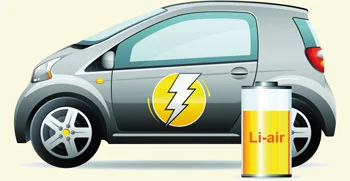The demands of electric cars, vehicles consumer goods, and electronic appliances such as smartphones, smart wearable, smart home appliances, etc. are continuously growing. At the same time, researchers have been working on smaller, powerful, efficient, and more durable post-lithium-ion batteries. One such potential alternative is Lithium-Air Battery also known as the lithium-oxygen battery.
In the last ten years, many materials for lithium-air battery systems have been reported by many researchers.
Theoretically, pairing lithium and ambient oxygen can lead to electrochemical cells with the highest possible specific energy, nearly 5 to 15 times, almost 3 times of power as compared to the traditional lithium-ion batteries and have the potential to store over 40 times the charge as that of a normal Li-Ion battery of similar weight. Lithium-Air batteries will primarily remain a research topic for at least the next five years. Even if the challenges are successfully addressed in that time period, the stringent requirements of durable and safe operation in an automotive environment will further delay commercialization. As a long-term solution to the daunting challenge of low-cost, high-range electromobility, Li-air batteries remain one of the few and most promising, and funding of research to accelerate their introduction into the marketplace should be a top priority for the government, academic, and industrial research institutes. Study the research papers to understand the working, types, various approaches, major challenges and their probable solutions. Get the PPT for seminars and presentations. Download research papers for seminar reports and projects.
In the last ten years, many materials for lithium-air battery systems have been reported by many researchers.
Theoretically, pairing lithium and ambient oxygen can lead to electrochemical cells with the highest possible specific energy, nearly 5 to 15 times, almost 3 times of power as compared to the traditional lithium-ion batteries and have the potential to store over 40 times the charge as that of a normal Li-Ion battery of similar weight. Lithium-Air batteries will primarily remain a research topic for at least the next five years. Even if the challenges are successfully addressed in that time period, the stringent requirements of durable and safe operation in an automotive environment will further delay commercialization. As a long-term solution to the daunting challenge of low-cost, high-range electromobility, Li-air batteries remain one of the few and most promising, and funding of research to accelerate their introduction into the marketplace should be a top priority for the government, academic, and industrial research institutes. Study the research papers to understand the working, types, various approaches, major challenges and their probable solutions. Get the PPT for seminars and presentations. Download research papers for seminar reports and projects.


0 comments